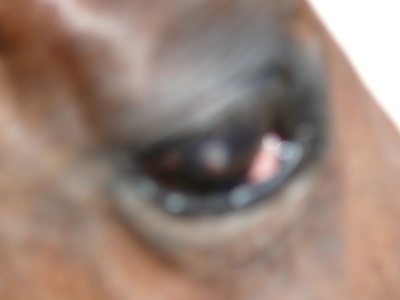By Chris, Five Star Ranch Staff Writer
This past March my older mare showed up at the barn one night with a runny eye. Upon inspection of the eye, we found a small splinter of wood in her eye. Eye injuries scare me, the risk of permanent blindness makes me always want to act fast on eye problems. In minutes we hooked up the trailer, loaded the mare and were enroute to our local vet.
The vet flushed the eye with a saline solution to clean it out. Then she put some Fluorescein in the eye to help see the injury. Fluorescein is an orange stain that dyes the eye green to highlight any injury or to detect foreign bodies in the eye.
The saline flush had washed out the splinter, but the eye was punctured. The vet applied antibiotic ointment into the eye and we were instructed to re-apply the ointment every 4 hours for the next few days. The vet wanted to prevent any eye infection from developing.
The vet also gave us some Banamine to help keep the mare more comfortable and alleviate pain.
Our vet suggested we keep her in a dark stall for the next few days and to put a fly mask on her to keep dust out of her eye. My clever husband designed a pirate’s patch to put on the outside of her fly mask to further protect the eye.
Ironically the eye injury occurred the day before we were hauling our horses to a week long horse vacation where we had planned to leave the older one at home in the care of a neighbor. We are great friends with the neighbor who has two horses of her own, but asking anyone to apply eye ointment to an unwilling patient every 4 hours seemed a little much to inflict on anyone.
The eye injury called for a slight change in plans. Instead of leaving her behind, my 30 year old mare got to go with us on our field trip. It was the perfect solution and my sweet-natured mare was bathed in attention. Everyone came by to see the patched one-eyed mare. She was soon everyone’s favorite buddy. How can you not love a sweet natured grandmotherly horse that nickers to everyone who walks by? She quickly became everyone’s friend.
After a week of the every 4 – 6 hour treatment we dropped back to twice a day with the ointment. That made everything much easier. Now we could “do the eye” when we fed.
Sadly, even with excellent treatment, my horse has a blind spot in her eye and may eventually lose her vision in that whole eye. I suppose if you are going to go blind, going blind slowly has some advantages. It gives you time to adjust, but still its a sad development. Watching how she navigates her way around I can see she now tilts her head in a way to give her good eye a better view of where she is going. She seems to be coping well.

Above you can see a (bad) picture of her eye. Did I mention she didn’t like me taking her picture? Even though the photograph is blurry, you can see the white spot on her eye. That is her new blind spot. (I promise to try to get a better picture and replace this one.)
Two years prior to this latest eye injury, this same mare had a freak accident where she tore part of her eyelid. Two vets had worked on the eye and ended up removing about a third of her eye lid. Although it is barely noticeable to casual viewing, her eye lid is smaller than normal. Since the eye splinter problem, I have wondered if the eye lid problem could have contributed to the splinter.
Flymasks are one way horse owners can help prevent eye injuries. The masks act to shield the eyes from hay or dust getting in the eye. Since the splinter incident, I have started using fly masks on my horses when they are in the pasture. I figure it can’t hurt and it may help save another eye.
Veterinary Books for the Horse Owner
Eye injuries are one of many ailments that can happen when you keep horses. Every horse person should have a good equine vet book around for emergencies and for general proper health care. I have the following vet books and keep them handy.